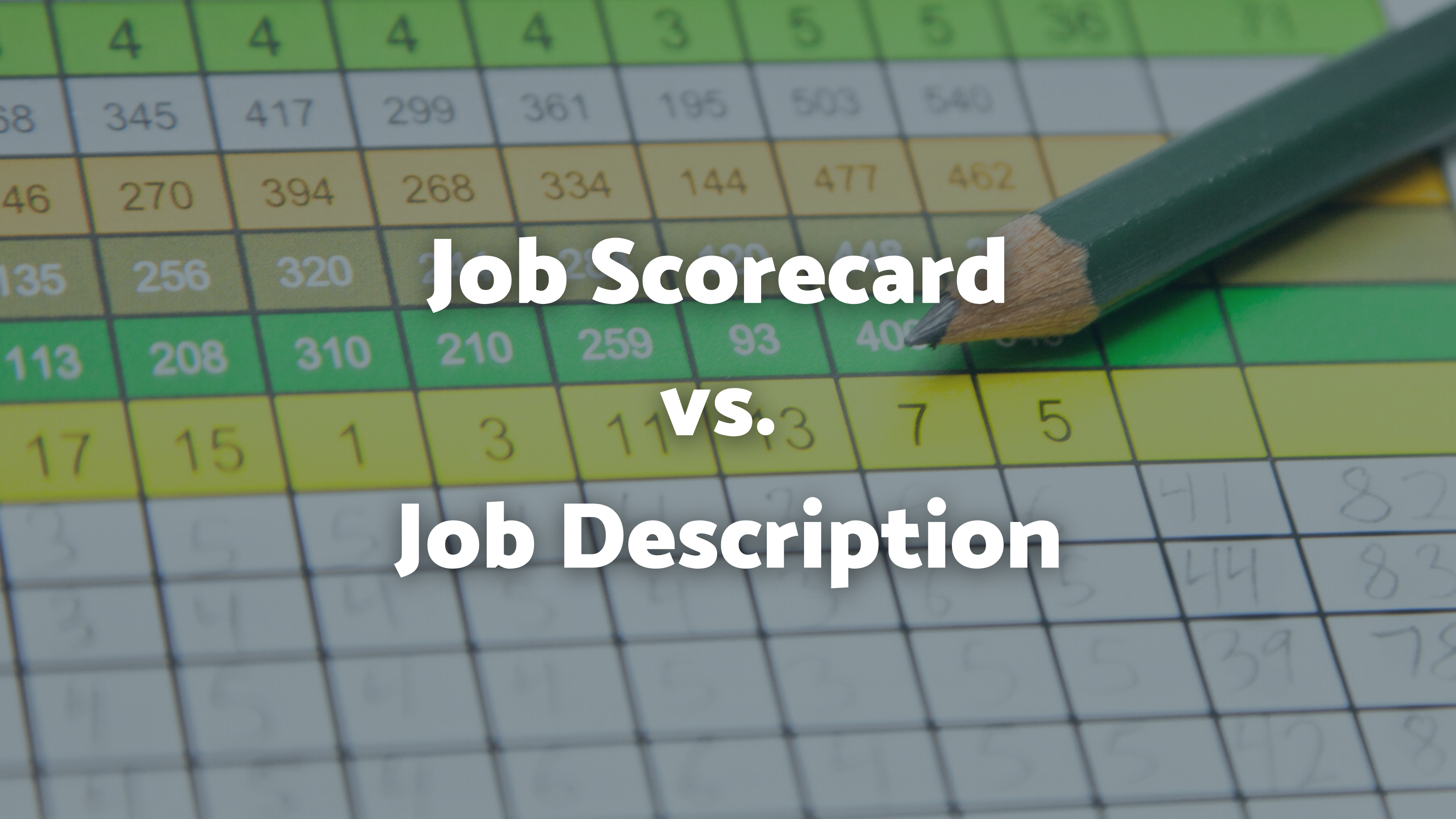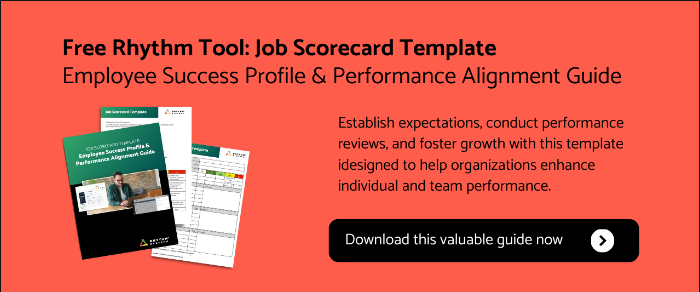Job Scorecards (or employee scorecards) have been a hot topic recently. Many companies are looking for a way. to provide more constant and balanced employee feedback and coaching while scaling up instead of just an annual review. The job scorecard approach allows company managers to achieve their strategic objectives.
The truth is that traditional annual performance reviews can be riddled with anxiety. Employees often perceive a connection to salary or a raise, which is stressful for everyone. The actual value of a performance review - an opportunity for development and coaching - should be noticed. The role and goal clarity that the employee scorecard provides enables managers to be more involved in employee performance.
As many of our clients embark on the Job Scorecard journey for performance evaluation (see Job Scorecard Template and Examples), the first hurdle is usually a mastery of terminology. I've found lots of confusion between a Job Description and a Job Scorecard (employee scorecard), and they both play pivotal roles in your organization. Here's the skinny:
- A Job Description is used externally for recruiting. It summarizes the role responsibilities and requirements of the job for potential candidates. It also outlines practical job details such as job location, full or part-time, travel requirements, education required, hourly or salary, commission, or bonus.
- A Job Scorecard (employee scorecard) is used internally for interviewing candidates and coaching existing employees. The scorecard sets expectations around job scorecard KPIs and expected results. It also serves as the framework for managers and their direct reports to rate performance. It is a coaching document that helps identify opportunities for development and improvement. It can be used quarterly, annually, or whenever a manager needs to discuss performance with a direct report.
Below are the Critical Areas of the Employee Scorecard Template:
Purpose of This Job:
Why this position exists. The overall and ultimate purpose within the organization is crucial for ensuring alignment with the company's mission and goals. By clearly defining the purpose of the role, employees can understand how their contributions directly impact the organization's success. This clarity helps to motivate employees, drive engagement, and enhance overall performance. Ultimately, establishing the purpose of the position sets the foundation for effective communication, goal setting, and success measurement within the organization.
Desired Results:
In addition to defining the desired results for this role, it is essential to outline the key performance indicators (KPIs) that the individual in this position is accountable for achieving. These KPIs serve as the measurable benchmarks that indicate success and progress towards organizational goals. Incorporating the SMART (Specific, Measurable, Achievable, Relevant, Time-bound) criteria, along with a Red-Yellow-Green rating system, helps to establish clear and objective standards for evaluating performance. By setting these expectations upfront, employees can focus on delivering results that align with the organization's strategic objectives and drive success.
Key Responsibilities:
This role will oversee specific actions, tasks, or areas of responsibility, ensuring that all operational objectives are met efficiently and effectively. From project management to team coordination, the individual in this position plays a vital role in driving productivity and achieving strategic goals. By closely monitoring performance metrics and providing guidance as needed, they help streamline processes, optimize workflows, and maintain a high level of quality in all deliverables. Their attention to detail and ability to prioritize tasks make them a key player in the success of the team and the organization as a whole.
Skills, Traits & Competencies:
Here are some specific skills, traits, and competencies that are essential for success in this role:
- Strong communication skills: The ability to effectively communicate with team members, stakeholders, and clients is crucial for ensuring smooth workflow and achieving project goals.
- Problem-solving abilities: Being able to think critically and find solutions to complex issues is a valuable asset in any role, especially when faced with challenges or obstacles.
- Time management skills: Efficiently managing time and prioritizing tasks is key to meeting deadlines and delivering high-quality work.
- Adaptability and flexibility: Being able to adapt to changing circumstances and adjust to new situations is essential for success in a dynamic work environment.
- Leadership qualities: Demonstrating leadership skills such as decision-making, delegation, and motivation can help drive team performance and achieve organizational objectives.
- Technical expertise: Possessing the necessary technical skills and knowledge related to the role is important for carrying out tasks effectively and efficiently.
These skills, traits, and competencies, when combined, can help individuals excel in their roles and contribute to the overall success of the organization.
Living Our Core Values:
This includes embodying the core values of the company in every aspect of their work, from communication to decision-making. Employees who demonstrate an understanding of and alignment with the company's stated Core Values showcase behaviors that reflect the organization's mission, vision, and culture. By consistently incorporating these values into their daily tasks and interactions, they contribute to a positive work environment and uphold the principles that guide the company toward its goals. This alignment not only fosters a sense of unity and cohesion within the team but also reinforces the company's identity and reputation. Employees who exemplify these core values serve as role models for their peers and help cultivate a strong organizational culture based on integrity, respect, and excellence.
The first step in using the Job Scorecard is to document each of these items for each role in the organization. Get input from the team and work on these together. Share Employee Scorecards with the entire team to promote role clarity throughout the company.
If the Job Scorecard is to be used in an interview with a potential candidate for that role, the Topgrading Scorecard guides the interviewer's questions. Based on the candidate’s responses, the interviewer can rank each item on a scale of 1-10. If multiple interviews occur, each interviewer can use the Job Scorecard similarly. This allows the interview panel to compare their rankings. The hiring experts at Topgrading also recommend using a Job Scorecard rather than a vague Job Description. If hiring, you should visit ten tips to hire and retain talent using the Topgrading methodology.
Job Scorecard vs. Job Description Video
If the Job Scorecard is to be used with a person currently serving in the role, the employee and their manager should rank their performance against each item listed.
For example, a good salesperson's skills include organization and detailed follow-up. The salesperson in that role might think they are a 10, while their manager thinks they are a 7. This prompts a discussion and uncovers a coaching opportunity for that manager.
Implementing Job Scorecards in your organization can be challenging, but it is simple. It does involve a shift in mindset - especially if your organization is in the habit of doing annual reviews. The best place to start is with yourself. Fill out your Job Scorecard and share it with your team. Ask for their input and go from there. Be careful; it's contagious!
If you want to increase accountability in your organization with Job Scorecards, download our free job scorecard template below. Your staff's learning and growth opportunities are well worth the small effort required to create the scorecard. Ensure that your balanced scorecards include objective measures for customers and employees to increase customer satisfaction and process improvements.





